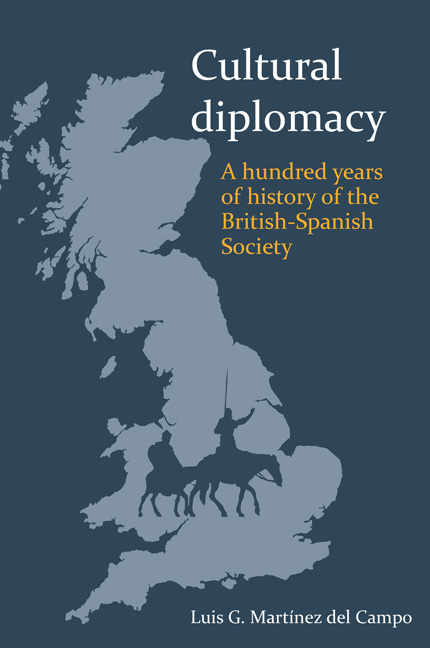Book contents
- Frontmatter
- Contents
- Joint Foreword
- Prologue
- English Edition
- Acknowledgements
- 1 Introduction
- 2 The foundation and expansion of the Anglo-Spanish Society (1916–1920)
- 3 The Anglo-Spanish Society in the interwar period
- 4 The rebirth: The League of Friendship (1950–1958)
- 5 A return to the origins: The new Anglo-Spanish Society
- 6 The Anglo-Spanish Society and Spanish democracy
- 7 Epilogue
- 8 Appendix: Memories of a retired member of the Executive Council of the Society by John Scanlan
- VERSIÓN EN ESPAÑOL
- Nota del autor
- 1 Introducción
- 2 Nacimiento y expansión de la Anglo-Spanish Society (1916–1920)
- 3 La Anglo-Spanish Society en el periodo de entreguerras
- 4 La reorganización: La Liga de la Amistad (1950–1958)
- 5 De vuelta a su origen: La nueva Anglo-Spanish Society
- 6 La Anglo-Spanish Society y la democracia
- 7 Epílogo
- 8 Apéndice: Cuadro de Cargos
- Index – English
- Index – Spanish
4 - The rebirth: The League of Friendship (1950–1958)
- Frontmatter
- Contents
- Joint Foreword
- Prologue
- English Edition
- Acknowledgements
- 1 Introduction
- 2 The foundation and expansion of the Anglo-Spanish Society (1916–1920)
- 3 The Anglo-Spanish Society in the interwar period
- 4 The rebirth: The League of Friendship (1950–1958)
- 5 A return to the origins: The new Anglo-Spanish Society
- 6 The Anglo-Spanish Society and Spanish democracy
- 7 Epilogue
- 8 Appendix: Memories of a retired member of the Executive Council of the Society by John Scanlan
- VERSIÓN EN ESPAÑOL
- Nota del autor
- 1 Introducción
- 2 Nacimiento y expansión de la Anglo-Spanish Society (1916–1920)
- 3 La Anglo-Spanish Society en el periodo de entreguerras
- 4 La reorganización: La Liga de la Amistad (1950–1958)
- 5 De vuelta a su origen: La nueva Anglo-Spanish Society
- 6 La Anglo-Spanish Society y la democracia
- 7 Epílogo
- 8 Apéndice: Cuadro de Cargos
- Index – English
- Index – Spanish
Summary
After World War II, British-Spanish relations remained frosty. Although Spain was theoretically out of the conflict, Franco had supported the German army with a military division, “la División Azul”, and had been ideologically in the side of the Italian Fascist State. Therefore, the Allies’ victory in 1945 caused the international isolation of the Spanish dictatorship, which was deliberately excluded. In 1946, governments of different countries (France, US, UK) did not authorise the admission of Spain as member of the United Nations, and the Spanish regime became marginalised in the international field until the beginning of the 1950s.
From the end of World War II to 1955, when Spain was accepted as member of the United Nations, Franco designed a diplomatic strategy to distance himself from the support he had given to Hitler. Consequently, Ramón Serrano Suñer and other fascist members of the regime were set aside. In the context of international isolation, the Spanish government showed interest in supporting institutions that wanted to improve the diplomatic relations between Spain and other countries in the post-war period. For this reason, Franco's dictatorship welcomed the efforts to reorganise the Anglo-Spanish Society, which had a potential interest for Spain's foreign policy.
In the early post-war period, a small group called “Friendship with Spain” was formed in London and, according to the limited amount of evidences that we have, tried to replace the Society that Henry Thomas and Edward Wilson had dissolved in 1947. However, this new organisation was also dissolved, so in 1950 the baton was picked up by another group: The Anglo-Spanish League of Friendship (which had different name, but the same principal members). The League was independent, but became linked to the Spanish Embassy in London, which supported the continuity of the association. Spanish diplomats wanted to take advantage of the League to promote a good image of Franco's dictatorship in the UK, but their wishes were against the non-political principles that the new institution defended. From the beginning, most members of the association were aware of the difficulties to remain politically neutral, under Spanish diplomatic pressure.
- Type
- Chapter
- Information
- Cultural DiplomacyA Hundred Years of the British-Spanish Society, pp. 52 - 62Publisher: Liverpool University PressPrint publication year: 2015



